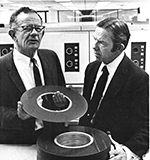-
(b.) -1913 July 10(d.)1997 September 29
Bio/Description
An American inventor and an engineer for IBM, he earned a degree in physics from Occidental College. He began his career as a high school science teacher in Los Angeles, and briefly worked in the aerospace industry for North American Aviation, Inc. before becoming an engineer at International Business Machines (IBM). His most acclaimed achievement is co-inventing, along with John Lynott, United States Patent 3,503,060, entitled ?Direct Access Magnetic Disc Storage Device?. He worked on wind tunnel work for North American Aviation and was to work on similar innovations for a Los Angeles airplane manufacturer at IBM, but shortly after he was hired, the contract for that project was dropped. He was instead, hired as an engineer, and became involved in the magnetic storage disk project when the United States Air Force called upon IBM in order to be ?mechanized?. The base required a mechanism to ?store data? virtually for its operations, and from this necessity, the disk storage project was conceived. He and John Lynott were key members of the San Jose, California?based engineering team, led by Reynold Johnson with the help of Louis Stevens, that developed the 350 Disk Storage Unit, a major component of the 305 RAMAC Computer. The magnetic disk drive symbolized a monumental advance in mass-storage technology. It is responsible for the end of sequential storage and batch processing with punched cards and paper tape. The CPU unit, also known as the 305 Processing unit, was responsible for the write-in and read-out operations of the IBM 350. ?Instructions? were provided to the unit coded as ?memory addresses?. These addresses referred to specific locations on the disc in which a transducer was either commanded to write-in or read-out data. His research began in the early 1950s at IBM?s Laboratory located on 99 Notre Dame Avenue in San Jose, CA. He did not see his work as particularly complex. As he puts it, ?it was not high tech, or very scientific. It was more like something you?d do in your garage.? It consisted of the magnetic disk memory unit with an access mechanism, the controls for the access mechanism, and a small air compressor. Assembled with covers, the 350 apparatus was 60 inches (1.52 m) long, 68 inches (1.73 m) high and 29 inches (0.74 m) deep. It was configured with 50 magnetic disks containing 50,000 sectors, each of which held 100 six-bit alphanumeric characters, for a capacity of 5 million six-bit characters. Disks rotated at 1,200 rpm, tracks were recorded at up to 100 bits per inch, and typical head-to-disk spacing was 800 microinches (20 ?m). The execution of a "seek" instruction positioned a read-write head to the track that contained the desired sector and selected the sector for a later read or write operation. Seek time averaged about 600 milliseconds. The key innovation was the air-bearing head, which ?floated? very close to the rotating disks without actually touching them, greatly increasing the speed of access. This air-bearing head, also known as a magnetic transducer, had the ability to move freely, which enabled the disk to be recorded and read from a vast number of different positions; the primary purpose of which was to allow the device to have rapid random access ability to any storage location. Additionally, the creation also allowed several magnetic discs to be mounted on a shaft in which a transducer could interact with more than one magnetic disk. An invention disclosure, filed on December 14, 1954 by the team resulted in two US Patents, 3,134,997, "Data Storage Machine" and subsequently 3,503,060, "Direct Access Magnetic Storage Disk Device" These patents make an analogy to how this invention acts hypothetically: ?the operation may be compared with the manner in which skilled operators select cards from a card file index.? Hard disk drives to this date follow the 350 Disk Storage Unit. They are used as the main components for storage on today?s personal computers. Similar to floppy disks, the data on hard drives are read and written via a spindle. Hard disk drives have many times more storage space than the IBM 350 due to considerable innovations in storage space densities on disks. Kryder's Law, similar to Moore's Law, indicates that storage space doubles on an annual basis. The Magnetic Disk Heritage Center has played an active role in preserving RAMAC 350 units Originally located at Santa Clara University, it has since moved to the Computer History Museum in Mountain View, CA. He was inducted in the National Inventors Hall of Fame with John Lynott in 2007 for their contribution to the invention of the first magnetic disk drive. It is hailed as one of the most significant inventions in the computer industry and it has since emerged to become an industry of its own with an annual revenue of $22 billion worldwide.
-
Date of Birth:
1913 July 10 -
Date of Death:
1997 September 29 -
Gender:
Male -
Noted For:
Co-inventor of the “Direct Access Magnetic Disc Storage Device”, which gave birth to the modern-day hard disk drive and is hailed as one of the most significant inventions in the computer industry -
Category of Achievement:
-
More Info:


